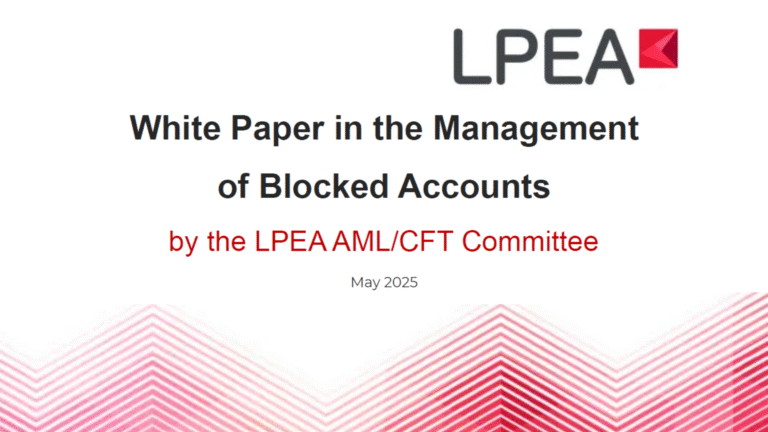By Julien Bieber, Partner, KPMG
EVEN THOUGH THE INITIAL REPORTING DEADLINES HAVE BEEN POSTPONED ACROSS MOST EUROPEAN UNION (EU) MEMBER STATES, THE MANDATORY DISCLOSURE RULES (MDR) OF COUNCIL DIRECTIVE (EU) 2018/822 AS AMENDED ON 25 MAY 2018 (DAC6) REMAIN A HOT TOPIC, WITH THE FIRST LUXEMBOURGISH REPORTING OBLIGATIONS KICKING IN AT THE BEGINNING OF 2021.
It will be a significant challenge for Private Equity (PE) houses to identify and assess all reportable arrangements across all EU Member States as of 25 June 2018.
Here, we highlight the main impact from a Luxembourg standpoint.
How has Luxembourg transposed DAC6?
The Luxembourg law dated 25 March 2020 (Mémorial A — N° 192 of 25 March 2020) transposed DAC6 into domestic law. After the EU allowed an optional six month deferral of DAC6 reporting deadlines, the law of 24 July 2020 (Mémorial
A — N° 638 of 24 July 2020) extended the Luxembourg deadlines by another six months, which was more than welcome by the financial players affected.
DAC6 AIMS TO IMPLEMENT NEW REPORTING
OBLIGATIONS OF CERTAIN CROSS-BORDER ARRANGEMENTS.
Julien Bieber
Most EU Member States also decided to implement this six-month deferral, except notably in Finland and Germany.
The new reporting deadlines for Luxembourg are:
- 30 January 2021 regarding arrangements triggering the reporting obligation between 1 July 2020 and 31 December 2020
- 28 February 2021 instead of 31 August 2020 for historical cross-border arrangements implemented between 25 June 2018 and 30 June 2020 (the so-called “retroactive reporting period”).
This deadline extension also means that sanctions and penalties for incomplete, inexact, late or absence of transmission of the reporting obligations laid out in EU Member States’ current laws should not be applied until the new deadlines enter into force. It is worth noting that penalties are determined by each EU Member State and can range between less than EUR1,000 in Italy and more than EUR5.5 million in Poland. In Luxembourg, the legislator has decided to set the penalty at an amount of up to EUR250,000.
What is the purpose of DAC6?
DAC6 aims to implement new reporting obligations of certain cross-border arrangements. This should enable EU tax authorities to quickly identify certain types of transactions that feature certain hallmarks, allowing EU Member States to take appropriate measures if undesirable tax effects are identified.
MDR are a global phenomenon and are implemented outside of the EU (for example, Mexico) as national implementations of the Organisation for Economic Co-operation and Development (OECD) BEPS Action 12.
Examples of hallmarks relevant to some PE houses
The most relevant hallmark for PE houses is hallmark C. This refers to cross-border deductible payments made between two or more associated enterprises (i.e. under the following alternative conditions: significant influence condition, or more than 25 percent of voting rights/of direct and indirect ownership in the capital, or at least 25 percent of profit entitlement, or the acting together concept).
Other notable examples are hallmark C-1-b-i, which applies when the recipient is resident for tax purposes in a jurisdiction that does not impose any corporate tax or imposes a corporate tax at the rate of zero or almost zero (e.g. Jersey or Cayman Island recipients), and hallmark C-1-c, which applies when the payment benefits from a full exemption from tax.
Meeting one of the hallmarks is generally not enough to consider an arrangement as reportable. It may need to be assessed if the main benefit test is met for some of them. Hallmark C1-b-ii, not subject to the main benefit test, refers to deductible cross-border payments made between two or more associated enterprises where the recipient is resident for tax purposes in a jurisdiction listed as being non-cooperative by the EU or OECD. For example, the Cayman Islands were on the EU list for several months in 2020 before being removed.
What does this mean in practice for PE houses?
Any cross-border arrangement that satisfies one of the hallmarks must be reported, within a specific timeframe, either by the intermediary involved in this specific arrangement or by the relevant taxpayer itself if the intermediary is covered by the legal professional privilege (LPP) or is located outside the EU, or if the arrangement is developed in-house with no intermediary involved.
As PE houses generally have a footprint in various EU jurisdictions — e.g. for their funds, management and advisory companies, holding and financing vehicles — any cross-border arrangement that meets a hallmark and involves more than one EU Member State or an EU Member State and a third country would need to be identified, assessed and potentially reported within a specific timeframe in various jurisdictions. Each jurisdiction may have transposed DAC6 differently into its local law and hallmarks may be subject to different interpretations in practice; for example, the understanding of hallmark A3 on standard documentation.
It is worth mentioning that, in practice, some investors are specifically focusing on the upcoming DAC6 obligations in their due diligence, asking fund managers how they are dealing with these new reporting obligations.
THE CLOCK IS TICKING, SO THE NEXT WEEKS MUST BE
DEDICATED TO BECOMING DAC6 READY AND WELL EQUIPPED TO FACE THIS NEW CHALLENGE.
Julien Bieber
Legal professional privilege (LPP) In Luxembourg, even if intermediaries are exempt from DAC6 reporting obligations because of their LPP status (i.e. lawyers, chartered accountants and auditors), they still have the obligation to notify within 10 days the other intermediaries and in the absence of any other intermediary not covered by LPP, the relevant taxpayers of their own reporting obligations. These obligations must be performed within 30 days from the same initial date — i.e. the day after the reportable cross-border arrangement is made available for implementation, or the day after it is ready for implementation, or when the first step of its implementation has been taken, whichever occurs first.
KPMG’s DAC6 Processor
The reporting obligation presents several challenges that must be properly addressed to avoid any reporting breach. As the rules and their interpretations have not been uniformly applied across the EU, this can result in an unclear allocation of responsibility between intermediaries and different rules around notifications, LPP status and deadlines. Plus, it can also be difficult to obtain the necessary data.
How can PE actors monitor their obligations and be “DAC6 ready”?
KPMG provides a tailor-made service to get PE houses DAC6 ready, including a three-stage modular approach and KPMG’s DAC6 Processor, an innovative MDR IT solution to categorize arrangements, monitor deadlines, perform the necessary reporting in each EU country and streamline the reporting process.
KPMG’s DAC6 Processor offers a personalized dashboard that optimizes your DAC6 compliance, providing an overview of assessments and reporting in line with a predefined policy. KPMG’s DAC6 Processor makes the reporting process as fast and efficient
as possible by mapping structured questionnaires based on local legislation, which can be used to collect and evaluate transactions and relevant information. This simplifies and streamlines the reporting process.
This tool allows PE houses to anticipate the DAC6 assessments of most recurrent cross-border arrangements with pre-completed questionnaires and arrangement reporting.
In line with this approach and assistance that is tailored to our specific client’s needs and domestic rules of each EU country, KPMG’s DAC6 Processor also allows the proper governance of the responsibility and actions taken by each intermediary or relevant taxpayer and helps monitor the reasons why each arrangement has been reported or not, providing a consistent approach across all countries and projects.
The clock is ticking, so the next weeks must be dedicated to becoming DAC6 ready and well equipped to face this new challenge.




